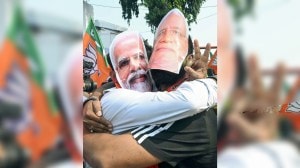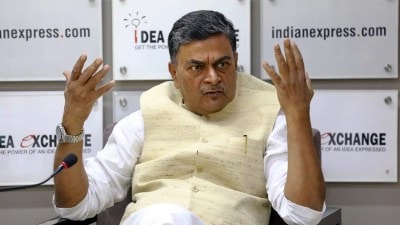No change in Chinese approach in Indo-Pacific since Ladakh negotiations: Navy chief Dinesh Tripathi
Ahead of Indian Navy Day on Dec 4, Navy chief Dinesh K Tripathi said the deal for Scorpene submarines and 26 Rafale marine aircraft could be signed by next month.
 Chief of the Naval Staff Admiral Dinesh K. Tripathi during a press meet, ahead of Navy Day (Express Photo by Amit Mehra)
Chief of the Naval Staff Admiral Dinesh K. Tripathi during a press meet, ahead of Navy Day (Express Photo by Amit Mehra)The thaw between Indian and Chinese forces in eastern Ladakh has not brought any change in the Chinese approach in the Indo-Pacific region and that remains a cause for concern, Indian Navy chief Admiral Dinesh K Tripathi said on Monday.
Tripathi was addressing the Navy’s annual press conference ahead of Indian Navy Day on December 4 which is being celebrated in Puri this year.
The Navy chief also suggested a nexus between China and Pakistan at the latter’s augmentation of naval strength. On his force’s impending acquisitions, Tripathi said the deal for Scorpene submarines and 26 Rafale marine aircraft could be signed by next month. The acquisitions would be significant as they would greatly enhance the Navy’s combat capabilities.
He said that the recent test fire of a ballistic missile from a nuclear submarine was successful and agencies concerned were examining its trajectory. The Indian Navy test-fired the 3,500 km ballistic missile from the newly inducted nuclear submarine INS Arighaat on Wednesday.
On a question as to whether the Navy had seen any perceptible change in China’s approach in the Indo-Pacific region following fruitful negotiations between India and China over Depsang plains and Demchok in eastern Ladakh, Tripathi said that in his view nothing had changed.
“China’s approach is too early to call. You are talking of wide swathe of Indo-Pacific region and whether it has changed or not. We have operated across the globe, including the South China sea. They have operated here. What is happening in South China Sea is not with us but with others. That is the cause for concern. Whether that has changed or not is in the open domain. In my view, I don’t think anything has changed. It is a cause for worry,” he said.
The Navy chief, however, underlined that the last known visit of a Chinese submarine in the Indian Ocean region was last year. “It went to Karachi and went back. After that we have not heard of any Chinese submarine coming in the Indian Ocean region,” Tripathi said.
According to Tripathi, the Navy had kept a close watch on the activities of “extra-regional forces operating in the Indian Ocean region which included the PLA Navy units”, referring to China’s People’s Liberation Army. “We knew who is doing what, where and how.”
“We believe that oceans are open to all. Anybody can operate in the oceans till the time they are not affecting our security… Whether it is A, B, C or D country. But we have established a structure to monitor what is happening. We will ensure there is no effect on our interests in the maritime domain,” he said.
The Navy chief suggested that the surprising growth of the Pakistani Navy was being spurred by China. “We are aware of the surprising growth of Pakistan Navy and they aim to become a 50-ship force by the next decade. Seeing the economy of Pakistan, it is very surprising how they are building or getting so many ships and submarines. Obviously, they have decided to choose between weapons over the welfare of their people. So, good luck to them,” he said.
According to Tripathi, a lot of Pakistani ships and submarines were either being built in China or with its help at the Karachi shipyard. “It shows China is interested in strengthening Pakistan Navy. The eight submarines being built for them will add significant combat potential to Pakistan Navy. We are fully aware what is happening, what is the level of their deployment, what is their coincept of operations. Therefore, we are tweaking ours as well to negate any infringement in our area of operation. We are fully ready to tackle all threats from our neighbours,” he said.
On Chinese activity in Bangladesh, Tripathi said, “We don’t know fully how close the relations between China and Bangladesh are. We are aware they have provided some platforms… provided help in creation of infrastructure, and there are some training efforts happening. We are not very concerned about it. We have good relations with Bangladesh.”
Tripathi said China was a rising power which wanted to attain its rightful place in the world. “There is intent and they have the resources. There is a vision that they want to become a world power. Whenever that happens there is friction with the established power. We see it already being played out. It will manifest more in the Pacific Ocean. But we are keeping a watch,” he said.
He said that all countries were working closely on the Indo-Pacific Partnership for Maritime Domain Awareness (IPMDA). “There is a wider acceptance that this needs to be fructified. It is for larger good of everybody and not just QUAD countries.” Quad refers to the four-nation grouping of Australia, India, Japan, and the United States. The IPMDA is a Quad initiative that provides maritime domain awareness information to partners in the Indo-Pacific region.
In terms of enhancing the Navy’s own capabilities, Tripathi said India was at an advanced stage of acquiring 26 Rafale marine combat aircraft. “Rafale marine (aircraft deal) is at an advanced stage of negotiations…and just one level short of taking it to the Cabinet Committee on Security following which a contract would be signed. It is a government-to-government deal so I expect it to happen fast,” he said.
According to Tripathi, the repeat order of Scorpene submarines is also at a very advanced stage. “It is now just a matter of completing formalities. We expect that if not this month, then by next month both this and Rafale should be signed,” he said.
On the ballistic missile test fire, Tripathi said, “We did carry out test of the non-warhead missile. It was successful. The concerned agencies are examining as to what trajectory the missile took. We will come back with that answer once that process is completed.”
According to the Navy chief, in the next 10 years, India will have 96 more ships and submarines of which 31 are being built in India, two in Russia and 31 more are in the pipeline. “Today 63 ships, including a submarine, are under construction in various Defence PSUs, PSUs and private shipyards in the country. There is an acceptance of necessity for 31 more ships which include very powerful stealth frigates, seven ships of Project 17 D, and six submarines of Project 75 India. We have also accepted the necessity of 60 helicopters to replace the ageing Chetak helicopters,” he said.
“We are very pleased to get government approval for the design and construction of two SSNs (nuclear-powered attack submarines). This indicates the government’s faith in our ability. A large number of platforms are awaiting induction in the next 12 months. On an average, one ship will be inducted every month for the next one year,” he added.
On the Navy’s role in controlling maritime piracy, Tripathi said, “You are aware that piracy had spiked in October in the Gulf of Aden and Horn of Africa region. We then deployed around 10 ships in the area. Because of our efforts, piracy was brought down and is under control now. We have not heard of any piracy for some time now. One ship is always there in the Gulf of Aden since 2008,” he said.
“The world acknowledges India’s economic prowess. We are aiming to become the world’s third-largest economy. All this requires sustained growth. Because 95 per cent of our trade by volume and 68 per cent by value transit through the seas, ensuring maritime security requires a strong Navy. That is our role… To make sure that there is order and discipline at sea so that our trade remains unhindered,” he added.







